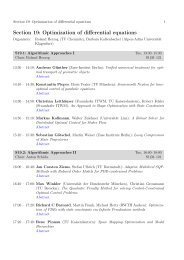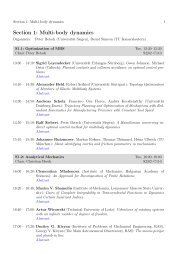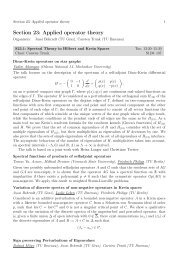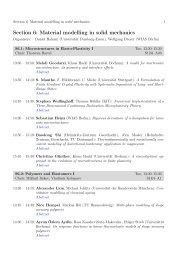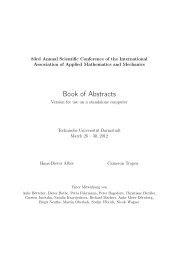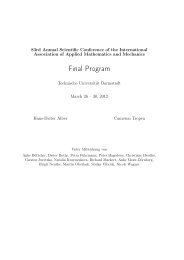Section 6: Material modelling in solid mechanics - GAMM 2012
Section 6: Material modelling in solid mechanics - GAMM 2012
Section 6: Material modelling in solid mechanics - GAMM 2012
Create successful ePaper yourself
Turn your PDF publications into a flip-book with our unique Google optimized e-Paper software.
32 <strong>Section</strong> 6: <strong>Material</strong> <strong>modell<strong>in</strong>g</strong> <strong>in</strong> <strong>solid</strong> <strong>mechanics</strong><br />
[1] Homberg, W., Dau, J., Damerow, U. Comb<strong>in</strong>ed Form<strong>in</strong>g of Steel Blanks with Local CFRP<br />
Re<strong>in</strong>forcement, <strong>in</strong>: G. Hirt, A. E. Tekkaya (Eds.), steel research <strong>in</strong>t., Special Edition: Proceed<strong>in</strong>gs<br />
of the 10th International Conference on Technology of Plasticity, Wiley-VCH,<br />
We<strong>in</strong>heim, 2011, pp. 441-446<br />
[2] Menzel, A., Modell<strong>in</strong>g and Computation of Geometrically Nonl<strong>in</strong>ear Anisotropic Inelasticity,<br />
Dissertation, University of Kaiserlautern, 2002<br />
[3] Tschoegl, N.W. The Phenomenologial Theory of L<strong>in</strong>ear Viscoelastic Behaviour, Spr<strong>in</strong>ger<br />
Verlag, 1989<br />
[4] Lion, A. and Höfer, P., On the phenomenological representation of cur<strong>in</strong>g phenomena <strong>in</strong><br />
cont<strong>in</strong>uum <strong>mechanics</strong>, Arch. Mech. 59, 2007<br />
On the axially compressed multiple walled carbon nanotubes<br />
Ligia Munteanu (Institute of Solid Mechanics of Romanian Academy)<br />
A new approach is proposed <strong>in</strong> this paper, which comb<strong>in</strong>es elements of Toup<strong>in</strong>-M<strong>in</strong>dl<strong>in</strong> stra<strong>in</strong><br />
gradient theory and the Molecular Mechanics to <strong>in</strong>clude the <strong>in</strong>layer van der Waals atomistic<br />
<strong>in</strong>teractions for axially compressed multiple walled carbon nanotubes. The neighbor<strong>in</strong>g walls of<br />
a multiwalled nanotube are coupled through van der Waals <strong>in</strong>teractions, and the shell buckl<strong>in</strong>g<br />
would <strong>in</strong>itiate <strong>in</strong> the outermost shell, when nanotubes are short. The load-unloaded-displacement<br />
curve, the critical buckl<strong>in</strong>g and the appropriate values for elastic moduli are obta<strong>in</strong>ed. The theoretical<br />
results obta<strong>in</strong>ed show a good agreement with the experimental data reported by Waters,<br />
Gudury, Jouzi and Xu (2005). The size dependence of the hardness with respect to the depth<br />
and the radius of the <strong>in</strong>denter is also <strong>in</strong>vestigated. Results show a peculiar size <strong>in</strong>fluence on the<br />
hardness, which is expla<strong>in</strong>ed via the shear resistance between the neighbor<strong>in</strong>g walls dur<strong>in</strong>g the<br />
buckl<strong>in</strong>g of the multiwalled nanotubes. The present method can be further extended to <strong>in</strong>vestigate<br />
the stress-stra<strong>in</strong> relations and the fracture behaviors of S/MWCNT<br />
From vortices to dislocations: How fluid <strong>mechanics</strong> can <strong>in</strong>spire <strong>solid</strong> <strong>mechanics</strong><br />
Markus Scholle (Hochschule Heilbronn)<br />
Although it is known for nearly a century that production and movement of dislocations are the<br />
elementary processes responsible for the plastic deformation of a <strong>solid</strong> body, all attempts to derive<br />
a cont<strong>in</strong>uum theory of plasticity from the discrete micro–theory of dislocations did not succeed<br />
<strong>in</strong> universally valid field equations like e.g. Navier–Stokes equations <strong>in</strong> fluid dynamics.<br />
In this paper an approach is presented based on an analogy between dislocations and vortex<br />
l<strong>in</strong>es <strong>in</strong> fluid flow. S<strong>in</strong>ce the dynamics of the latter ones is well understood <strong>in</strong> terms of the Navier–<br />
Stokes equations, it is near at hand to make use of this analogy <strong>in</strong> order to establish a k<strong>in</strong>d of<br />
’Navier–Stokes equations for the distorsion tensor’.<br />
Start<strong>in</strong>g from Clebsch’s variational formulation for <strong>in</strong>viscid flow, a relation beween the symmetries<br />
of the Lagrangian and the balance of vorticity result<strong>in</strong>g from it is shown giv<strong>in</strong>g rise for<br />
the construction of another Lagrangian from which the respective dislocation balance results.<br />
The present state of the theory is discussed.<br />
On the connection of dissipation and deviatoric stress <strong>in</strong> the cont<strong>in</strong>uum theory of<br />
defects<br />
Johannes Schnepp (RWTH Aachen)



